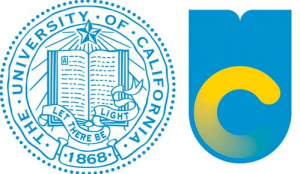Here are the dueling logos. Which could possibly be the new one?

This time last year, protest was no stranger to the University of California. Public outcry over rising tuition costs and police brutality spread across the network of West Coast campuses, gathering the attention of the national media and consoling those that thought student protest was dead.
This winter a new foe has emerged, once again throwing the UCs into the national spotlight and garnering, as I post this, 52,303 petitioners on Change.org. What is the nemesis? The new UC logo, part of a large-scale rebranding campaign by UC officials.
I am a UC graduate and I guess I’m part of the angry mob. While spending an unnecessary amount of time on Facebook, I came across a friend’s status that said, “If you like the old UC logo, then sign this.” I clicked to the petition’s link, looked at the side-by-side comparison of the old and new, and in five seconds decided a) yes, I’m signing this because b) the new logo is ugly. It was simple. I was able to join a quickly spreading movement while sitting in my pajamas.
UC officials have stressed that the old UC crest is not gone; it dignifiedly remains on diplomas and other official documents. The new logo is about branding the University of California as a network of campuses, they explain, creating a coherent identity that can be stamped onto websites and coffee mugs. It’s hip and it’s fresh and why don’t we just understand that?
But protests continue. New signatures are added to the online petition every day. The Atlantic’s James Fallows created a cheeky quiz testing readers on their “visual IQ” (if you like the old logo, congratulations, you passed). This morning, California’s lieutenant governor, Gavin Newsom, by virtue of his office as UC regent, announced that he too wants the traditional logo restored to its former glory. He writes, “Instead of being creative with the University of California logo, we should be searching for creative solutions for funding the University of California.”
Slow clap to that proposition, sir, but wasn’t the new logo introduced—albeit quietly—six months ago? And the creative team formed to rebrand the UC system put together three and a half years ago? Why is a regent only now commenting on his disapproval?
Perhaps it has to do with the massive social media campaign that emerged once old-UC-crest-supporters tumbled to the logo switcheroo. Spreading across Twitter and Facebook like wildfire, anti-new-logo tweets and statuses have convinced people they hated a logo they didn’t even know existed.
This suggests social media is a particularly persuasive form of communication, one that allows huge networks to simultaneously voice their displeasure at such speed that politicians savvy to the Facebook world have no choice but to stop and take notice.
John Jones of West Virginia University believes in social media’s power. In his article, “Social Media and Persuasion: Crowdsourcing Arguments on Digital Networks,” Jones argues that as a hybrid of oral and written communication, social media’s ability to influence opinion is particularly powerful.
Jones explains that a regular oral argument captures our attention because we are witnessing an event, and that in itself comes with a degree of importance and immediacy. Written communication, however, is what a rational audience will accept; text alludes to authority and permanency. Social media combines these elements and, in Jones’ words, “This leaves social media users with the impression that the propositions in question are doubly true, by virtue of their being both immediate and permanent.”
Jones continues, “In order for communicators to be effective they must address social media as social media” – meaning that if you want the people logged into social media to like you, you need to contact them through social media. When that’s not done, and the always ready-to-fight internet turns its head to see the opposition isn’t playing in the game, an “us versus them” mentality occurs.
In 2010, thousands of tweets and statuses protested the Gap logo change. Public disapproval was so intense that Gap apologized, announced they would return to the old and loved logo and all was forgiven. How did they contact their angry patrons? Through Facebook.
There was no big reveal for the new UC logo. Four weeks ago an Apple-esque video was put out by the University of California to promote the change, but its participation in social media has been minimal. But while the UC quietly spends whatever amount of money it costs to rebrand a huge network, a back channel of angry communication is able to take place by the people who feel most affected by UC decisions.
Participants in the social media world—those that the new logo hopes to market to as being “innovative” and “bold”—expect communication and transparency in the decisions that affect them. Sure, it’s just a new logo, but it represents an institution that many feel deeply about. Maybe social media participation wouldn’t have saved the new logo’s reputation, but it would have helped create the impression that this is a decision made by a community—not “the man.” Or at least it would have given the UC a heads-up on damage control.


